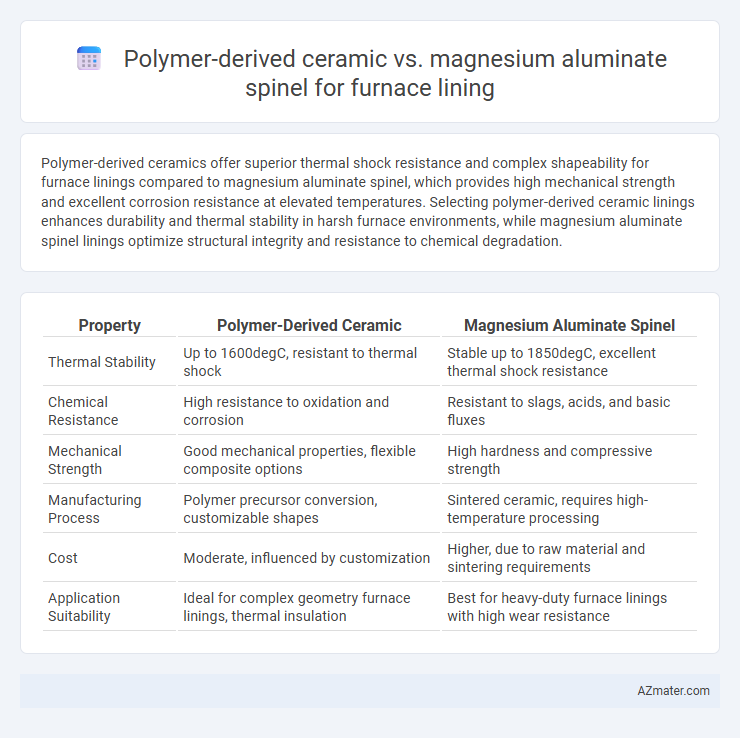Polymer-derived ceramics offer superior thermal shock resistance and complex shapeability for furnace linings compared to magnesium aluminate spinel, which provides high mechanical strength and excellent corrosion resistance at elevated temperatures. Selecting polymer-derived ceramic linings enhances durability and thermal stability in harsh furnace environments, while magnesium aluminate spinel linings optimize structural integrity and resistance to chemical degradation.
Table of Comparison
| Property | Polymer-Derived Ceramic | Magnesium Aluminate Spinel |
|---|---|---|
| Thermal Stability | Up to 1600degC, resistant to thermal shock | Stable up to 1850degC, excellent thermal shock resistance |
| Chemical Resistance | High resistance to oxidation and corrosion | Resistant to slags, acids, and basic fluxes |
| Mechanical Strength | Good mechanical properties, flexible composite options | High hardness and compressive strength |
| Manufacturing Process | Polymer precursor conversion, customizable shapes | Sintered ceramic, requires high-temperature processing |
| Cost | Moderate, influenced by customization | Higher, due to raw material and sintering requirements |
| Application Suitability | Ideal for complex geometry furnace linings, thermal insulation | Best for heavy-duty furnace linings with high wear resistance |
Introduction to Furnace Lining Materials
Polymer-derived ceramics (PDCs) offer high thermal stability and excellent resistance to oxidation, making them suitable for advanced furnace lining applications. Magnesium aluminate spinel provides outstanding mechanical strength and thermal shock resistance, commonly used in traditional furnace linings. The choice between PDCs and spinel depends on the furnace operating temperature, chemical environment, and desired lifespan.
Overview of Polymer-Derived Ceramics (PDCs)
Polymer-derived ceramics (PDCs) are advanced materials produced through the pyrolysis of preceramic polymers, resulting in ceramics with exceptional thermal stability, oxidation resistance, and mechanical strength, making them ideal for high-temperature furnace linings. These ceramics exhibit superior resistance to thermal shock and chemical corrosion compared to traditional inorganic ceramics like magnesium aluminate spinel, enabling longer service life in aggressive furnace environments. The tunable microstructure and compositional versatility of PDCs allow customization for specific refractory applications, enhancing performance in demanding industrial processes.
Key Characteristics of Magnesium Aluminate Spinel
Magnesium aluminate spinel (MgAl2O4) offers exceptional thermal stability and chemical resistance, making it highly suitable for furnace lining applications. Its high melting point of approximately 2135degC, excellent mechanical strength, and resistance to slag corrosion ensure long service life under extreme conditions. Compared to polymer-derived ceramics, spinels provide superior refractoriness and resistance to thermal shock, enhancing the durability of furnace linings in steelmaking and glass industry environments.
Thermal Stability: PDCs vs Magnesium Aluminate Spinel
Polymer-derived ceramics (PDCs) exhibit superior thermal stability compared to magnesium aluminate spinel in furnace lining applications, maintaining structural integrity at temperatures exceeding 1700degC. Magnesium aluminate spinel, while offering good thermal shock resistance up to around 1400degC, tends to degrade under prolonged exposure to extreme temperatures and reactive atmospheres. PDCs' amorphous to nanocrystalline microstructure enhances their resistance to thermal cycling and oxidation, making them more reliable for high-temperature environments.
Mechanical Strength and Durability Comparison
Polymer-derived ceramics exhibit superior mechanical strength and thermal shock resistance compared to magnesium aluminate spinel, making them highly durable under extreme furnace conditions. Magnesium aluminate spinel offers excellent chemical stability and high melting points but tends to have lower fracture toughness, leading to potential brittleness over prolonged thermal cycling. Polymer-derived ceramics maintain structural integrity with enhanced crack resistance, resulting in longer service life for furnace lining applications.
Chemical Resistance and Corrosion Protection
Polymer-derived ceramics exhibit superior chemical resistance and corrosion protection compared to magnesium aluminate spinel when used for furnace lining due to their amorphous structure and strong covalent bonding, which enhance stability against aggressive slags and high-temperature gases. Magnesium aluminate spinel offers excellent thermal stability and mechanical strength but is more prone to corrosion from acidic environments and alkali attack, compromising its longevity in harsh furnace conditions. The polymer-derived ceramic's tailored microstructure provides enhanced resistance to oxidation and chemical degradation, making it a preferred choice for demanding industrial furnace applications.
Fabrication and Installation Processes
Polymer-derived ceramics (PDCs) offer greater fabrication flexibility for furnace linings thanks to their ability to be molded into complex shapes before pyrolysis, reducing installation time and enhancing fit precision. Magnesium aluminate spinel requires high-temperature sintering and machining, which can increase fabrication complexity and prolong installation due to its rigid crystalline structure. PDCs typically enable near-net shaping and faster curing cycles, resulting in lower labor costs and quicker turnaround during furnace lining maintenance or refurbishment projects.
Cost Analysis: PDCs vs Spinel Linings
Polymer-derived ceramic (PDC) furnace linings generally offer lower initial material costs compared to magnesium aluminate spinel linings, due to cheaper raw materials and simpler manufacturing processes. However, magnesium aluminate spinel provides superior thermal stability and longer service life, reducing replacement frequency and overall maintenance expenses. Lifecycle cost analysis often favors spinel linings in high-temperature applications, where durability outweighs upfront investment savings of PDCs.
Application-Specific Suitability in Furnace Environments
Polymer-derived ceramics offer excellent thermal shock resistance and chemical inertness, making them suitable for high-temperature furnace linings subjected to rapid temperature fluctuations and corrosive gases. Magnesium aluminate spinel demonstrates superior mechanical strength and thermal stability, ideal for furnace environments with heavy mechanical wear and prolonged exposure to extreme heat. The application-specific suitability depends on balancing thermal endurance and mechanical robustness to optimize furnace lining longevity and performance.
Future Trends and Innovations in Furnace Lining Materials
Polymer-derived ceramics (PDCs) are gaining traction in furnace lining applications due to their superior thermal stability, oxidation resistance, and customizable microstructures, enabling enhanced performance in extreme environments. Magnesium aluminate spinel remains a staple for its excellent mechanical strength and thermal shock resistance, but innovations now focus on hybrid composites integrating PDC matrices with spinel fillers to optimize durability and reduce maintenance cycles. Future trends emphasize nano-engineering and additive manufacturing to produce furnace linings with tailored porosity and phase distribution, driving advancements in energy efficiency and operational lifespan.

Infographic: Polymer-derived ceramic vs Magnesium aluminate spinel for Furnace lining
 azmater.com
azmater.com